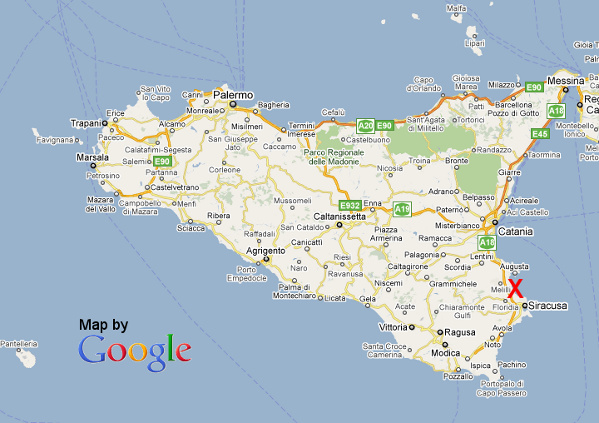| Tikalon Blog is now in archive mode.
An easily printed and saved version of this article, and a link
to a directory of all articles, can be found below: |
|
This article |
| Directory of all articles |
Solar Salt
July 30, 2010
Solar energy is a wonderful renewable energy resource. For smaller solar power plants, such as those for point-of-generation residential and business power,
photovoltaic power is the easiest technology to implement. The cost of photovoltaic panels has dropped considerably over the years, but they're still quite expensive. Presently, photovoltaic panels can be had for a little more than $4.00 per peak watt.[1]
Larger installations can use an indirect conversion of solar energy into electricity by creating steam, for example, to drive conventional steam turbine-generators. In a typical application, large parabolic troughs concentrate sunlight to heat a medium, such as water, in a pipe at their focal point.
The one problem that affects all solar installations is that they generate only when the sun shines. There are parallel research efforts to store the daytime energy from such plants for nightime use. Some are as exotic as
charging superconducting inductors, or as prosaic as pumping water uphill. There is, however, a way for these solar power facilities to store their energy in the working fluid, itself. This approach has been used in the Archimede solar thermal power plant at Priolo Gargallo, near
Syracuse, Sicily.[2-6]

Location of the Archimede solar thermal power plant at Priolo Gargallo, near Syracuse, Sicily (Google maps)
The Archimede plant is named after the famous
Syracusean,
Archimedes, who is
credited with using solar energy to delay the invasion of Syracuse by a Roman fleet during the
Siege of Syracuse. The approach used at the Archimede plant, storing energy in the
latent heat of fusion of low melting salts, is not new. It was done in demonstration solar plants in the
US Mojave desert, and in Spain.[7] The archetypal salt,
sodium chloride, melts at 801
o C, which is a little too high to be useful for this application; but
sodium nitrate melts at 308
o C, and
potasium nitrate melts at 334
o C. Mixtures of salts have even lower melting temperatures, as shown in the table.[8]
| Salt Mixture | Molar Composition | Liquidus (o C) |
| Eutectic | (NaNO3)50(KNO3)50 | 221 |
| Binary Solar Salt | (NaNO3)66(KNO3)34 | 238 |
| Lowest melting | (KNO3)20.7 (NH4NO3)60.2(AgNO3)19.1 | 52 |
| Hitec® HTS | (NaNO3)7(KNO3)44(NaNO3)49 | 141 |
Surprisingly, these molten salts are not
corrosive to most metals and alloys, including
stainless steels and
ferrous alloys.[8] Of special interest is the Hitec® solar nitrate salt, produced by Coastal Chemical Co., L.L.C., Houston, Texas. [9] This composition has the same properties as the eutectic mixture, but it's less expensive. Its latent heat of fusion is 57 BTU/lb (1 Btu/lb = 0.556 kcal/kg = 2,326 J/kg), and the volume density of heat is 43 BTU/ft
3-
oF. This salt mixture is chemically stable up to 1100
oF.[9]
The Archimede plant, built by the Italian power group,
Enel, is using the eutectic mixture.[5] The heat of the molten salt is used to create steam to drive conventional turbine-generators. Archimede contains 30,000 square meters of solar mirrors and 5,400 meters of salt-carrying pipes. It can generate 5 MW of electrical power, enough to offset 2,100 tons of oil each year.[5] The cost of the plant is about 60 million Euros, giving a per megawatt cost slightly higher than a nuclear power plant. However, the molten salts are not consumed, and they are environmentally benign, unlike nuclear fuel, so the cost of waste disposal is far less. The only trick is keeping the salts molten during extended cold periods, but the plant has proved that it can generate power at all times of the day.
Notice the
English unit, BTU/lb. If you've ever wondered how "lb" became the abbreviation for "pound," here's the answer. The Latin word for a balance, or measuring scale, is "libra," and the Roman unit of mass, also called libra, is about 327 grams. This weight is 0.721 pounds, which, as my father (a building contractor) would say, "is close enough for digging."
References:
- Solar Module Retail Price Environment from Solarbuzz, Solar Energy Research and Consultancy (July, 2010)
- Philip Proefrock, "World's First Molten Salt Solar Plant Produces Power at Night," Inhabitat.com, July 22, 2010.
- ENEL opens "world's first" molten-salt/solar plant, The Engineer (UK), July 14, 2010.
- Sam Biddle, "Impossible Sounding Solar Plant Generates Electricity At Night," Gizmodo (Australia), July 23, 2010.
- Enel just opened Archimede, a new innovative solar plant in Sicily, SicilyGuide, July 14, 2010.
- At Priolo Enel Inaugurates the "Archimede" Power Plant, Enel Press Release, July 14, 2010.
- The Solar Project, from Wikipedia.
- Robert W. Bradshaw and Nathan P. Siegel, "Molten Nitrate Salt Development for Thermal Energy Storage in Parabolic Trough Solar Power Systems," Paper ES2008-54174 of the Proceedings of Energy Sustainability 2008 (August 10-14, 2008, Jacksonville, Florida USA).
- Hitec® Solar Salt, Coastal Chemical Co., L.L.C. Web Site.
- J. Buschle, W.D. Steinmann, and R. Tamme, "Latent Heat Storage For Process Heat Applications," German Aerospace Center, Institute of Technical Thermodynamics, Stuttgart, Germany
Permanent Link to this article
Linked Keywords: Solar energy; photovoltaic; superconducting inductors; Syracuse, Sicily; Syracusean; Archimedes; Siege of Syracuse; latent heat of fusion; US Mojave desert; sodium chloride; sodium nitrate; potasium nitrate; corrosive; stainless steels; ferrous alloys; Enel; English unit